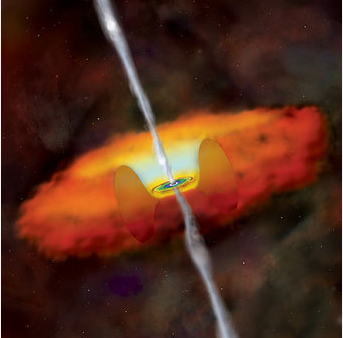
Phd Thesis
Site: Merate (LC)
Duration
3 years
Tutors
Sara Motta
Contact
sara.motta AT inaf.it
Description
The inflow of matter onto astronomical objects is connected to the generation of collimated outflows (or jets) throughout the Universe, from proto-planetary disks, to merging neutron stars and gamma ray bursts, to stellar mass and supermassive black holes.
The inflow of matter onto compact objects and their jets are mostly studied independently, thus they are observed in the X-rays and radio, respectively, typically at different times and often in an incoherent way.
As a result, we still largely do not understand how accretion leads to the launch of jets, and how much matter and energy jets release into the environment.
X-ray binaries are double systems formed by an ordinary star and a compact object (black hole or neutron star), where accretion yields the fastest jets observed within our galaxy.
The fastest outflows known, the Ultra-Relativistic Outflows (URFs), were discovered as unresolved flows of energy propagating at almost the speed of light through the jets from the neutron star binary Sco X-1.
The URFs might be the fastest phenomenon seen from objects within our Galaxy, and yet they remain completely unexplained.
While URFs were observed in two more sources, Sco X-1 remains the best example of a URF producing source.
As such, in 2019 Sco X-1 was targeted by a dedicated multi-wavelength observing campaign, the largest to date dedicated to a neutron star X-ray binary.
Such a campaign delivered the longest, uninterrupted, strictly simultaneous monitoring in the X-rays and radio ever obtained on a binary, featuring the best quality data currently achievable, supported by extended simultaneous multi-wavelength coverage.
The main aim of this thesis is to unveil the nature of the mysterious URFs, which have never been studied in deep before.
The PhD candidate will work with Dr.ssa Sara E. Motta, who personally led the multi-wavelength campaign on Sco X-1.
S/he will use mainly data from the radio and X-ray band, and will employing a number of analysis methods and techniques best suited to maximally exploit the data, which include radio and X-ray imaging, Fourier analysis techniques for the study of the fast time-variability, and multi-band spectral analysis.
The PhD candidate will (i) investigate the generation of URFs in Sco X-1 by probing the inflow/outflow processes at the same time using cutting-edge VLBI radio imaging and advanced timing and spectral-timing techniques; (ii) determine the properties of URFs in other accreting neutron star X-ray binaries using both existing (archival and proprietary) and new data which will be requested on suitable targets; (iii) search for URFs around stellar-mass black holes, by making use of existing datasets which already hinted at the existence of URFS, but have never been investigated before.
The PhD candidate will be involved in the proposal for new observations and will have the opportunity to join the ThunderKAT collaboration (dedicated to the exploitation of data from the MeerKAT radio telescope) and will be leading the observing proposals to obtain the data required to the completion of this project. The candidate will also lead at least three papers over the course of the project.
The results achieved with this project have the potential to ultimately revolutionize our understanding of accretion and outflows in accreting systems.
URFs might play a major role not only in the feedback from Galactic X-ray binaries, but also in the super-massive BH at the center of massive galaxies, and hence might have impacted the formation of structure in the early Universe.
[Crediti immagine: MPE]
